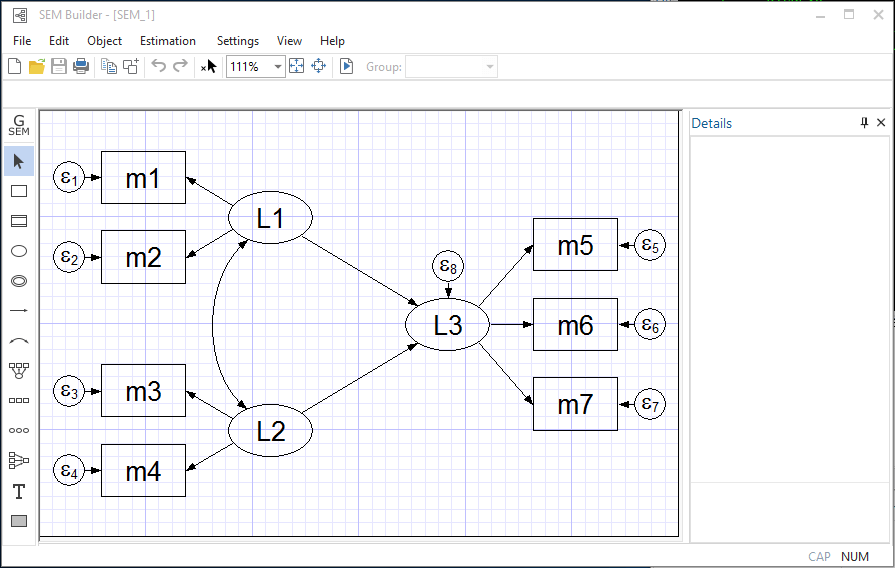
Direct and indirect effects for linear SEM 

- Confidence intervals
- Unstandardized or standardized units
Overall goodness-of-fit statistics for linear SEM 
- Model vs. saturated
- Baseline vs. saturated
- RMSEA, root mean squared error of approximation
- AIC, Akaike's information criterion
- BIC, Bayesian information criterion
- CFI, comparative fit index
- TLI, Tucker–Lewis index, a.k.a. nonnormed fit index
- SRMR, standardized root mean squared residual
- CD, coefficient of determination
Equation-level goodness-of-fit statistics for linear SEM 
- R-squared
- Equation-level variance decomposition
- Bentler–Raykov squared multiple-correlation coefficient
Group-level goodness-of-fit statistics for linear SEM 
- SRMR
- CD
- Model vs. saturated chi-squared contribution
Residual analysis for linear SEM 
- Mean residuals
- Variance and covariance residuals
- Raw, normalized, and standardized values available
Parameter tests
- Modification indices

- Wald tests


- Score tests

- Likelihood-ratio tests


- Easy to specify single or joint custom tests for omitted paths, included
paths, and relaxing constraints
- Linear and nonlinear tests of estimated parameters
- Tests may be specified in standardized or unstandardized parameter units

Group-level parameter tests 
- Group invariance by parameter class or user specified
Linear and nonlinear combinations of estimated parameters 
- Confidence intervals
- Unstandardized or standardized units

Assess nonrecursive system stability 
Predictions for linear SEM 

- Observed endogenous variables
- Latent endogenous variables
- Latent variables (factor scores)
- Equation-level first derivatives
- In- and out-of-sample prediction; may estimate on one sample and form
predictions in another
Predictions for generalized SEM 


- Means of observed endogenous variables—probabilities for 0/1
outcomes, mean counts, etc.
- Linear predictions of observed endogenous variables
- Latent variables using empirical Bayes means and modes
- Standard errors of empirical Bayes means and modes
- Observed endogenous variables with and without
predictions of latent variables
- Density function
- Distribution function
- Survivor function
- Predict observed endogenous variables marginally with respect to latent variables
- User-defined nonlinear predictions
Results
- May be used with postestimation features
- May be saved to disk for restoration and use later
- Displayed in standardized or unstandardized units

- Optionally display results in Bentler–Weeks form

- Optionally display results in exponentiated form as odds ratios,
incidence rate ratios, and relative risk ratios


- All results accessible for community-contributed programs
Factor variables with generalized SEM 
- Automatically create indicators based on categorical variables
- Form interactions among discrete and continuous variables
- Include polynomial terms
- Perform contrasts of categories/levels
Marginal analysis 
Contrasts for generalized SEM 
- Analysis of main effects, simple effects, interaction effects, partial
interaction effects, and nested effects
- Comparisons against reference groups, of adjacent levels, or against the
grand mean
- Orthogonal polynomials
- Helmert contrasts
- Custom contrasts
- ANOVA-style tests
- Contrasts of nonlinear responses
- Multiple-comparison adjustments
- Balanced and unbalanced data
- Contrasts of means, intercepts, and slopes
- Graphs of contrasts
- Interaction plots
Pairwise comparisons for generalized SEM 
- Compare estimated means, intercepts, and slopes
- Compare marginal means, intercepts, and slopes
- Balanced and unbalanced data
- Nonlinear responses
- Multiple-comparison adjustments: Bonferroni, Sidak, Scheffe, Tukey HSD,
Duncan, and Student–Newman–Keuls adjustments
- Group comparisons that are significant
- Graphs of pairwise comparisons
Explore more about SEM in Stata.
Additional resources

![]()
![]()
![]()
![]()
![]()
![]()
![]()

![]()
![]()
![]()
![]()
![]()
![]()
![]()
![]()
![]()
![]()
![]()
![]()
![]()